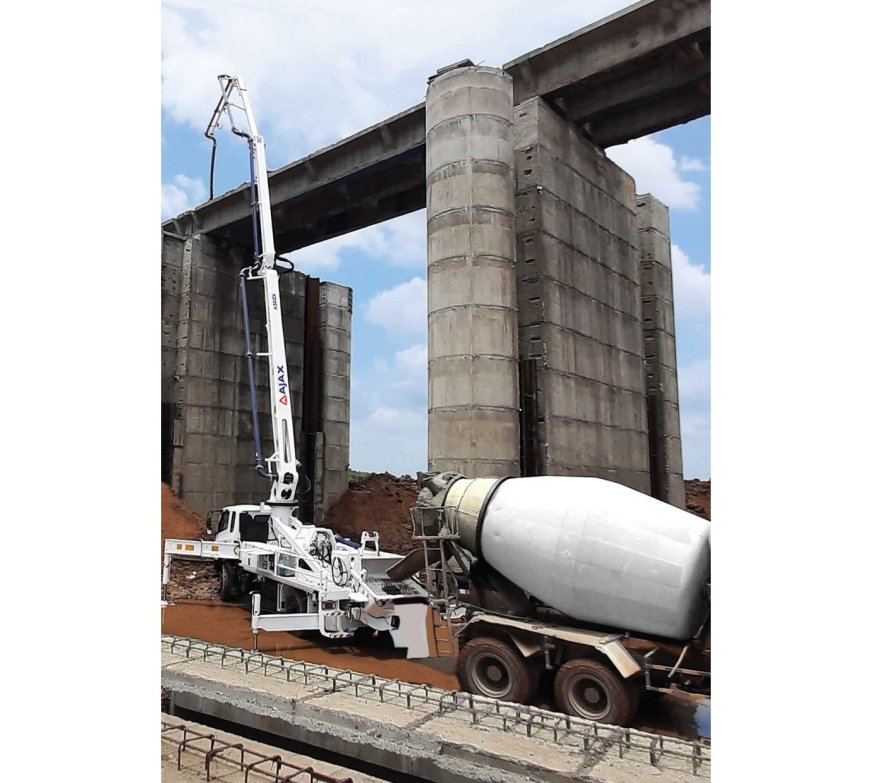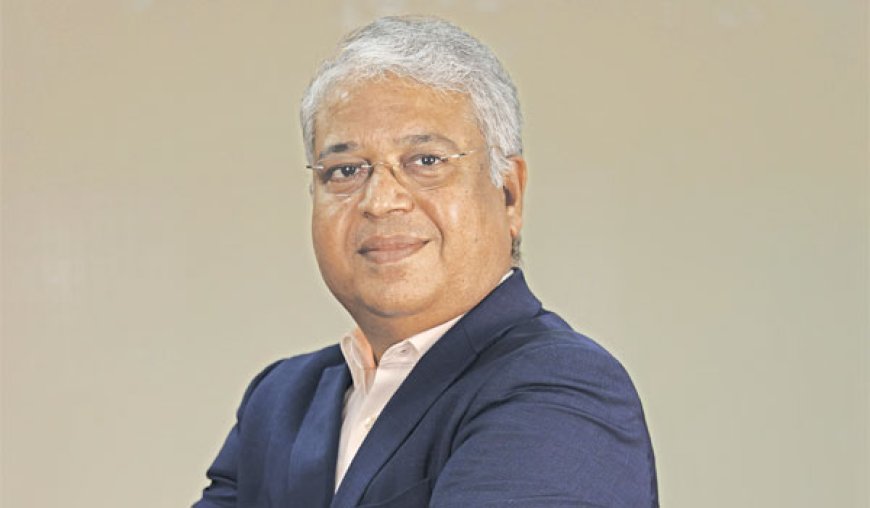Building Better, Faster, Stronger
The Role of Advanced Concrete Machinery The Indian concrete equipment sector has witnessed significant growth and transformation over the years. With rapid urbanization, infrastructural development, and government initiatives like “Make in India” and “Smart Cities,” the demand for modern and

The Role of Advanced Concrete Machinery
The Indian concrete equipment sector has witnessed significant growth and transformation over the years. With rapid urbanization, infrastructural development, and government initiatives like “Make in India” and “Smart Cities,” the demand for modern and efficient concrete equipment has surged. Equipment Times delves into the key aspects of the Indian concrete equipment sector, exploring its current state, recent advancements, challenges, and the promising opportunities that lie ahead.
The Indian concrete equipment sector has grown substantially in recent years. According to reports, the market size is estimated to be around USD 1.2 billion, with a compound annual growth rate (CAGR) of approximately 8-10% in the past decade.
The sector is home to both domestic and international players. Prominent Indian companies like Schwing Stetter, Putzmeister, and KYB-Conmat have established a strong presence. Additionally, international giants such as Caterpillar, SANY, and Liebherr have also made substantial investments in the Indian market.
The Indian concrete equipment sector has seen a remarkable shift towards advanced technologies. Automation, telematics, and IoT integration are becoming increasingly common in concrete equipment, improving efficiency and reducing downtime.
Recent Advancements in the Indian Concrete Equipment Sector
Self-Loading Concrete Mixers: The introduction of self-loading concrete mixers has been a game-changer in the construction industry. These machines are equipped with self-weighing and batching systems, enhancing the accuracy and speed of concrete mixing. Companies like Ajax Fiori and Universal Construction Machinery have been pioneers in this domain.
Green Concrete Equipment: Sustainability is a growing concern, and the Indian concrete equipment sector is responding with eco-friendly solutions. Manufacturers are producing concrete equipment that supports the use of alternative and recycled materials, reducing the carbon footprint of construction projects.
Compact Batching Plants: Compact batching plants have gained popularity due to their small footprint and versatility. These plants are suitable for urban construction projects with limited space. Companies like Macons and Apollo have been leaders in this segment.
The Indian market for concrete equipment is a dynamic and rapidly growing sector driven by urbanization, infrastructure development, and government initiatives. This market encompasses a wide range of equipment used in the production, transportation, and placement of concrete for construction projects. Let’s delve into the key aspects of the Indian market for concrete equipment:
Market Size and Growth:
The Indian market for concrete equipment has witnessed significant growth in recent years, driven by the country’s booming construction industry.
The market size is estimated to be around USD 1.2 billion, with projections of steady growth in the coming years.
Factors contributing to this growth include increased government spending on infrastructure projects, urbanization, and a growing demand for modern construction techniques.
The Indian market features a mix of domestic and international players. Prominent domestic manufacturers include Schwing Stetter, Putzmeister, KYB-Conmat, and Ajax Fiori.
International companies like SANY, Liebherr, and Caterpillar also have a significant presence and have made substantial investments in India.
Government Initiatives
The Indian government has launched initiatives such as “Make in India,” “Smart Cities,” and “Housing for All” to boost infrastructure development and affordable housing projects. These initiatives create substantial demand for concrete equipment.
Technological Advancements
The sector is experiencing technological advancements, with the incorporation of automation, telematics, and IoT into concrete equipment. These technologies enhance efficiency and reduce downtime.
Export Opportunities
Indian manufacturers have been increasingly looking at international markets to export concrete equipment, benefiting from cost-effective manufacturing and quality products.
Challenges
Despite its growth, the sector faces challenges such as complex regulations, varying standards across states, and the need for skilled operators and technicians.
In conclusion, the Indian market for concrete equipment is vibrant and poised for sustained growth. The increasing investment in infrastructure development, affordable housing projects, and technological advancements in equipment are driving factors for the sector. To fully harness the potential of this market, addressing regulatory challenges and investing in skill development will be essential for manufacturers and stakeholders in the industry.
Challenges Faced by the Indian Concrete Equipment Sector
Infrastructure Gaps: Despite significant growth, India still faces infrastructure challenges. Inadequate road connectivity, port facilities, and power supply can hinder the transportation and operation of concrete equipment.
Regulatory and Compliance Issues: The sector is subject to various regulations and standards, which can be complex and varied across states. Harmonizing these regulations is crucial for the growth of the industry.
Skill Gap: Operating and maintaining modern concrete equipment requires skilled technicians. Bridging the skill gap and providing adequate training is essential to ensure the efficient use of equipment.
Opportunities on the Horizon
Rural and Affordable Housing: The government’s initiatives to provide affordable housing in rural areas present a significant opportunity for the concrete equipment sector. The demand for small and versatile equipment for these projects is expected to rise.
Infrastructure Development: India’s ambitious infrastructure projects, such as the development of expressways, metros, and airports, offer substantial growth prospects for the sector. Advanced concrete equipment will be in high demand to meet the construction requirements.
Export Potential: Indian manufacturers have the potential to expand their footprint in international markets, especially in regions with similar construction demands. The “Make in India” initiative can support this expansion.
The Indian concrete equipment sector is poised for continued growth and innovation. Recent advancements in technology, coupled with opportunities in infrastructure development and affordable housing, make this sector a promising investment. However, addressing challenges such as regulatory issues and skill gaps will be essential for sustainable growth. With the right strategies and investments, the Indian concrete equipment sector can cement its position as a vital contributor to the nation’s construction and infrastructure development.
Leaders speak…
 V G. Sakthikumar, CMD, Schwing Stetter India, said, “One of our most popular concrete equipment products is the concrete truck mixer. In this product category, we have a 90% market share in India, and we also cater heavily to the export market. One of the models of Transit Mixers from SCHWING Stetter India is the AM 8 (C2), which has a nominal capacity of 8 cubic meters. This means that it can carry up to 8 cubic meters of concrete per trip. The total geometric volume of the mixer drum is 14170 liters, and the waterline volume is 8838 liters. The filling ratio is 56.5%, which indicates the percentage of the drum volume that is filled with concrete. The AM 8 (C2) has a diesel engine with a power output of 79 kilowatts, which provides sufficient torque and speed for the mixer. The drum speed can be adjusted from 0 to 12 revolutions per minute, depending on the mixing and discharge requirements. The AM 8 (C2) also has a water tank with a volume of either 500 or 650 liters, which can be used for cleaning the mixer drum and adding water to the concrete mix.”
V G. Sakthikumar, CMD, Schwing Stetter India, said, “One of our most popular concrete equipment products is the concrete truck mixer. In this product category, we have a 90% market share in India, and we also cater heavily to the export market. One of the models of Transit Mixers from SCHWING Stetter India is the AM 8 (C2), which has a nominal capacity of 8 cubic meters. This means that it can carry up to 8 cubic meters of concrete per trip. The total geometric volume of the mixer drum is 14170 liters, and the waterline volume is 8838 liters. The filling ratio is 56.5%, which indicates the percentage of the drum volume that is filled with concrete. The AM 8 (C2) has a diesel engine with a power output of 79 kilowatts, which provides sufficient torque and speed for the mixer. The drum speed can be adjusted from 0 to 12 revolutions per minute, depending on the mixing and discharge requirements. The AM 8 (C2) also has a water tank with a volume of either 500 or 650 liters, which can be used for cleaning the mixer drum and adding water to the concrete mix.”
He further added, “We have a rigorous quality control process in place to ensure that our concrete equipment meets the highest standards of durability and reliability. Our quality control process begins at the design stage, where we use state-of-the-art engineering software to simulate the performance of our equipment under real-world conditions. Once a design is finalized, it is thoroughly tested in our laboratory before being put into production.
Our production facilities are equipped with the latest manufacturing technologies and quality control procedures. We use only the highest quality materials and components in our equipment, and we perform rigorous inspections at every stage of the production process. All of our equipment is also tested and commissioned before it is shipped to the customer.”
 Shubhabrata Saha, MD and CEO, Ajax Engineering, said, “Ajax Engineering employs comprehensive of quality control measures to guarantee the utmost durability and reliability of our concrete equipment. Beginning with cutting-edge design processes that utilize advanced engineering software and tools, we meticulously scrutinize every aspect of our equipment’s structural integrity and performance. Our commitment extends to material selection, where we choose only the highest-quality, corrosion-resistant materials. Our skilled workforce, comprise of experienced engineers and technicians, who ensure precision throughout the manufacturing process. Rigorous testing, encompassing load testing, stress testing, and performance evaluations, detects and addresses any issues before our products reach customers. Furthermore, we value and incorporate customer feedback into our continuous improvement process, allowing us to adapt and enhance our products over time. Ajax Engineering’s concrete equipment stands as a testament to our unwavering dedication to delivering durability and reliability that exceeds customer expectations.”
Shubhabrata Saha, MD and CEO, Ajax Engineering, said, “Ajax Engineering employs comprehensive of quality control measures to guarantee the utmost durability and reliability of our concrete equipment. Beginning with cutting-edge design processes that utilize advanced engineering software and tools, we meticulously scrutinize every aspect of our equipment’s structural integrity and performance. Our commitment extends to material selection, where we choose only the highest-quality, corrosion-resistant materials. Our skilled workforce, comprise of experienced engineers and technicians, who ensure precision throughout the manufacturing process. Rigorous testing, encompassing load testing, stress testing, and performance evaluations, detects and addresses any issues before our products reach customers. Furthermore, we value and incorporate customer feedback into our continuous improvement process, allowing us to adapt and enhance our products over time. Ajax Engineering’s concrete equipment stands as a testament to our unwavering dedication to delivering durability and reliability that exceeds customer expectations.”
He further added, “At AJAX, we place a strong emphasis on ensuring that our customers have the knowledge and skills required to efficiently operate and maintain our concrete equipment. We offer comprehensive training programs designed to empower our customers’ site staff in various aspects of machine operation and maintenance. Our training initiatives are multifaceted, encompassing both classroom and on-site training sessions conducted throughout the year. To ensure continuous skill enhancement, AJAX has established a valuable partnership with the Infrastructure Equipment Skill Council of India (IESC). Our Training Centre in Bangalore serves as the hub for scheduled classroom training sessions. These sessions cover a wide range of topics, including equipment maintenance best practices, troubleshooting exercises, proper operating procedures, and select service workshops. To provide a hands-on learning experience, participants are given the opportunity to visit our assembly line in the factory and nearby job sites. This practical exposure enhances their understanding of our equipment’s functionality and maintenance requirements.”
 Siva Ramalingam, Managing Director, Fiori Concrete Machines India, said, “Fiori Concrete Machines India Pvt Ltd, is a dedicated new facility in Chennai, India, for manufacturing Fiori Self-Loading Concrete Mixers. We will be producing four models, DBX 2500, DBX 5000, DBS 2800 & DBS 4300. The DBX series represents our state of the art and unique X-Generation Front Loading mixer system & the DBS series represents the Rear Loading mixer system. They have a batch capacity of 2.5/5.0/2.8/4.3 cbm respectively. The X-Generation Self Loading Concrete Mixer with Front Loading arrangement is one of the most popular models across the world. The X-Generation SLM is a front-loading mixer with reduced foot-print, which is easy to operate and maintain, ensures safety & high level of productivity. Fiori machines are highly compact & maintain stability even in difficult terrains. The Fiori Batching Controller System monitors and controls the batching process and eliminates any manual error. This ensures repeatable consistency for any given mix design batch after batch.”
Siva Ramalingam, Managing Director, Fiori Concrete Machines India, said, “Fiori Concrete Machines India Pvt Ltd, is a dedicated new facility in Chennai, India, for manufacturing Fiori Self-Loading Concrete Mixers. We will be producing four models, DBX 2500, DBX 5000, DBS 2800 & DBS 4300. The DBX series represents our state of the art and unique X-Generation Front Loading mixer system & the DBS series represents the Rear Loading mixer system. They have a batch capacity of 2.5/5.0/2.8/4.3 cbm respectively. The X-Generation Self Loading Concrete Mixer with Front Loading arrangement is one of the most popular models across the world. The X-Generation SLM is a front-loading mixer with reduced foot-print, which is easy to operate and maintain, ensures safety & high level of productivity. Fiori machines are highly compact & maintain stability even in difficult terrains. The Fiori Batching Controller System monitors and controls the batching process and eliminates any manual error. This ensures repeatable consistency for any given mix design batch after batch.”
He adds, “The concept of Self-loading concrete mixers ensures that there is minimum travel between the place of production of concrete & the place of usage of concrete. This ensures production of concrete with the least consumption of fossil fuel. The front-loading arrangement & the grab bucket design ensures optimum productivity and efficient use of fuel to produce more in the same amount of time. The ergonomically designed cabin & smooth travel and operations ensure operator comfort. The focus at World of Concrete would be to educate, update different customer segments about Fiori products and the technological advancements that Fiori India would be bringing to India.”
Hits: 17








